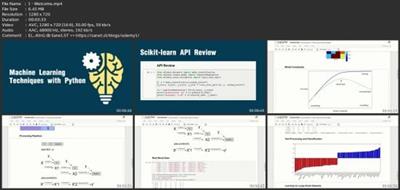Last updated 6/2022
MP4 | Video: h264, 1280x720 | Audio: AAC, 44.1 KHz
Language: English | Size: 474.24 MB | Duration: 3h 40m
Learn all the advanced skills you need to perform various real-world machine learning tasks in different environments.
What you'll learn
Extract features from categorical variables, text, and images
Solve real-world problems using machine learning techniques
Exploit the power of Python to handle data extraction, manipulation, and exploration techniques
Implement machine learning classification and regression algorithms from scratch in Python
Dive deep into the world of analytics to predict situations correctly
Predict the values of continuous variables
Classify documents and images using logistic regression and support vector machines
Create ensembles of estimators using bagging and boosting techniques
Evaluate the performance of machine learning systems in common tasks
Requirements
Knowledge of some undergraduate level mathematics would be an added advantage
Description
Data science and machine learning are some of the top buzzwords in the technical world today. Machine learning is the buzzword bringing computer science and statistics together to build smart and efficient models. Using powerful algorithms and techniques offered by machine learning you can automate any analytical model.
Python is one of the most popular languages used for machine learning and arguably, the best entry point to the fascinating world of machine learning (ML). If you're interested to explore both the programming and machine learning world with python, then go for this course.
In this course, you will work through various examples on advanced algorithms, and focus a bit more on some visualization options. We'll show you how to use random forest to predict what type of insurance a patient has based on their treatment and you will get an overview of how to use random forest/decision tree and examine the model. And then, we'll walk you through the next example on letter recognition, where you will train a program to recognize letters using a support Vector machine, examine the results, and plot a confusion matrix. With the help of various projects included, you will find it intriguing to acquire the mechanics of several important machine learning algorithms - they are no more obscure as they thought. You will build systems that classify documents, recognize images, detect ads, and more. You will learn to use scikit-learn's API to extract features from categorical variables, text and images; evaluate model performance, and develop an intuition for how to improve your model's performance.
At the end of this course, you will master all required concepts of machine learning to build efficient models at work to carry out advanced tasks with the practical approach.
Overview
Section 1: Introduction
Lecture 1 Welcome
Section 2: Getting Started With This Course
Lecture 2 Set up the environment
Lecture 3 Machine Learning - Classification
Lecture 4 Machine Learning - Regression
Lecture 5 Machine Learning - Transformers
Lecture 6 Machine Learning - Clustering
Lecture 7 Machine Learning - Manifold Learning
Lecture 8 Machine Learning - Scikit-learn's estimator interface
Lecture 9 Machine Learning - Cross-Validation
Lecture 10 Machine Learning - Grid Searches
Section 3: Machine Learning - Model Complexity
Lecture 11 Introduction
Lecture 12 Linear models for regression
Lecture 13 Support Vector Machines
Lecture 14 Trees and Forests
Lecture 15 Learning Curves
Lecture 16 Validation Curves
Lecture 17 EstimatorCV Objects for Efficient Parameter Search
Section 4: Understanding Pipelines
Lecture 18 Pipelines - Motivation
Lecture 19 Pipeline Baiscs
Lecture 20 Cross Validation With Pipelines
Lecture 21 Using Pipelines with Grid-Search
Section 5: Machine Learning - Imbalanced Classes & Metrics
Lecture 22 Default metrics
Lecture 23 Classification Metrics
Lecture 24 Precision - Recall tradeoff and Area Under the Curve
Lecture 25 Built-In and custom scoring functions
Section 6: Machine Learning - Model Selection For Unsupervised Learning
Lecture 26 How to evaluate unsupervised models?
Lecture 27 Kernel Density Estimation
Lecture 28 Model Selection For Clustering
Section 7: Machine Learning - Handling Real Data
Lecture 29 Dealing with Real Data
Lecture 30 OneHotEncoder
Lecture 31 Encoding Features from Dictionaries
Lecture 32 Handling missing values
Section 8: Machine Learning - Dealing with Text Data
Lecture 33 Text Data Motivation
Lecture 34 Text Feature Extraction with Bag-of-Words
Lecture 35 Text Classification of Movie Reviews
Lecture 36 Text Classification continuation
Lecture 37 Text Feature Extraction Hashing Trick
Lecture 38 Vector Representations
Section 9: Machine Learning - Out Of Core Learning
Lecture 39 Out of Core and Online Learning
Lecture 40 The Partial Fit Interface
Lecture 41 Kernel Approximations
Lecture 42 Subsampling for supervised transformations
Lecture 43 Out of core text classification with the Hashing Vectorizer
Section 10: Course Summary
Lecture 44 Course Summary
Section 11: Code Files
Lecture 45 Working Files
Lecture 46 Thank You
The course is intended for both professionals and students.,Anyone who wants to learn advanced machine learning skills
rapidgator.net:
uploadgig.com:Kod:https://rapidgator.net/file/25bf3fe0e8919067e6961fb2e9942bd3/tdagh.Artificial.Intelligence.Advanced.Machine.Learning.rar.html
1dl.net:Kod:https://uploadgig.com/file/download/c562a685Ef1d0643/tdagh.Artificial.Intelligence.Advanced.Machine.Learning.rar
nitroflare.com:Kod:https://1dl.net/zrni6fed0dth/tdagh.Artificial.Intelligence.Advanced.Machine.Learning.rar.html
Kod:https://nitroflare.com/view/9908A15B946D9D1/tdagh.Artificial.Intelligence.Advanced.Machine.Learning.rar
2 sonuçtan 1 ile 2 arası
Threaded View
-
16.09.2022 #1Üye



- Üyelik tarihi
- 20.08.2016
- Mesajlar
- 145.658
- Konular
- 0
- Bölümü
- Bilgisayar
- Cinsiyet
- Kadın
- Tecrübe Puanı
- 154
Artificial Intelligence Advanced Machine Learning
Konu Bilgileri
Users Browsing this Thread
Şu an 1 kullanıcı var. (0 üye ve 1 konuk)



 LinkBack URL
LinkBack URL About LinkBacks
About LinkBacks






 Alıntı
Alıntı
Konuyu Favori Sayfanıza Ekleyin